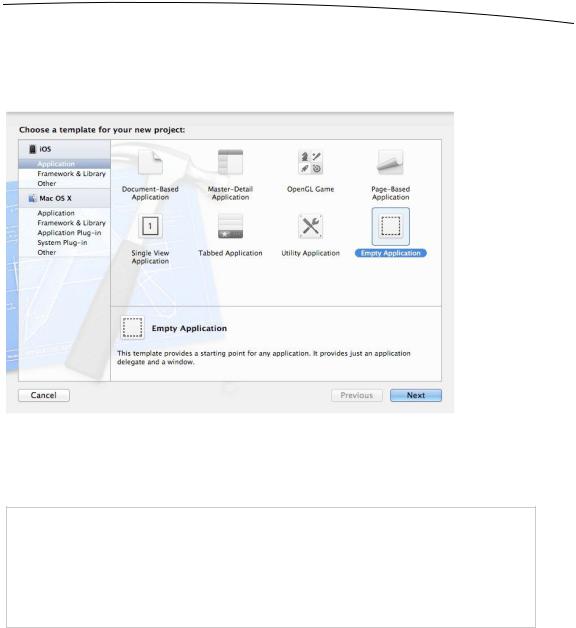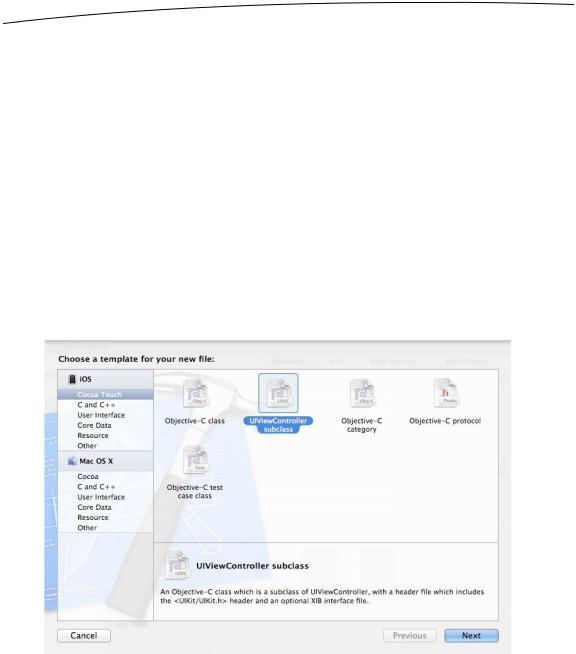
- •Contents at a Glance
- •About the Authors
- •About the Technical Reviewer
- •Acknowledgments
- •Preface
- •What This Book Is
- •What You Need
- •Developer Options
- •What You Need to Know
- •What’s Different About Coding for iOS?
- •Only One Active Application
- •Only One Window
- •Limited Access
- •Limited Response Time
- •Limited Screen Size
- •Limited System Resources
- •No Garbage Collection, but…
- •Some New Stuff
- •A Different Approach
- •What’s in This Book
- •What’s New in This Update?
- •Are You Ready?
- •Setting Up Your Project in Xcode
- •The Xcode Workspace Window
- •The Toolbar
- •The Navigator View
- •The Jump Bar
- •The Utility Pane
- •Interface Builder
- •New Compiler and Debugger
- •A Closer Look at Our Project
- •Introducing Xcode’s Interface Builder
- •What’s in the Nib File?
- •The Library
- •Adding a Label to the View
- •Changing Attributes
- •Some iPhone Polish—Finishing Touches
- •Bring It on Home
- •The Model-View-Controller Paradigm
- •Creating Our Project
- •Looking at the View Controller
- •Understanding Outlets and Actions
- •Outlets
- •Actions
- •Cleaning Up the View Controller
- •Designing the User Interface
- •Adding the Buttons and Action Method
- •Adding the Label and Outlet
- •Writing the Action Method
- •Trying It Out
- •Looking at the Application Delegate
- •Bring It on Home
- •A Screen Full of Controls
- •Active, Static, and Passive Controls
- •Creating the Application
- •Implementing the Image View and Text Fields
- •Adding the Image View
- •Resizing the Image View
- •Setting View Attributes
- •The Mode Attribute
- •Interaction Checkboxes
- •The Alpha Value
- •Background
- •Drawing Checkboxes
- •Stretching
- •Adding the Text Fields
- •Text Field Inspector Settings
- •Setting the Attributes for the Second Text Field
- •Creating and Connecting Outlets
- •Closing the Keyboard
- •Closing the Keyboard When Done Is Tapped
- •Touching the Background to Close the Keyboard
- •Adding the Slider and Label
- •Creating and Connecting the Actions and Outlets
- •Implementing the Action Method
- •Adding Two Labeled Switches
- •Connecting and Creating Outlets and Actions
- •Implementing the Switch Actions
- •Adding the Button
- •Connecting and Creating the Button Outlets and Actions
- •Implementing the Segmented Control Action
- •Implementing the Action Sheet and Alert
- •Conforming to the Action Sheet Delegate Method
- •Showing the Action Sheet
- •Spiffing Up the Button
- •Using the viewDidLoad Method
- •Control States
- •Stretchable Images
- •Crossing the Finish Line
- •The Mechanics of Autorotation
- •Points, Pixels, and the Retina Display
- •Autorotation Approaches
- •Handling Rotation Using Autosize Attributes
- •Configuring Supported Orientations
- •Specifying Rotation Support
- •Designing an Interface with Autosize Attributes
- •Using the Size Inspector’s Autosize Attributes
- •Setting the Buttons’ Autosize Attributes
- •Restructuring a View When Rotated
- •Creating and Connecting Outlets
- •Moving the Buttons on Rotation
- •Swapping Views
- •Designing the Two Views
- •Implementing the Swap
- •Changing Outlet Collections
- •Rotating Out of Here
- •Common Types of Multiview Apps
- •The Architecture of a Multiview Application
- •The Root Controller
- •Anatomy of a Content View
- •Building View Switcher
- •Creating Our View Controller and Nib Files
- •Modifying the App Delegate
- •Modifying BIDSwitchViewController.h
- •Adding a View Controller
- •Building a View with a Toolbar
- •Writing the Root View Controller
- •Implementing the Content Views
- •Animating the Transition
- •Switching Off
- •The Pickers Application
- •Delegates and Data Sources
- •Setting Up the Tab Bar Framework
- •Creating the Files
- •Adding the Root View Controller
- •Creating TabBarController.xib
- •The Initial Test Run
- •Implementing the Date Picker
- •Implementing the Single-Component Picker
- •Declaring Outlets and Actions
- •Building the View
- •Implementing the Controller As a Data Source and Delegate
- •Implementing a Multicomponent Picker
- •Declaring Outlets and Actions
- •Building the View
- •Implementing the Controller
- •Implementing Dependent Components
- •Creating a Simple Game with a Custom Picker
- •Writing the Controller Header File
- •Building the View
- •Adding Image Resources
- •Implementing the Controller
- •The spin Method
- •The viewDidLoad Method
- •Final Details
- •Linking in the Audio Toolbox Framework
- •Final Spin
- •Table View Basics
- •Table Views and Table View Cells
- •Grouped and Plain Tables
- •Implementing a Simple Table
- •Designing the View
- •Writing the Controller
- •Adding an Image
- •Using Table View Cell Styles
- •Setting the Indent Level
- •Handling Row Selection
- •Changing the Font Size and Row Height
- •Customizing Table View Cells
- •Adding Subviews to the Table View Cell
- •Creating a UITableViewCell Subclass
- •Adding New Cells
- •Implementing the Controller’s Code
- •Loading a UITableViewCell from a Nib
- •Designing the Table View Cell in Interface Builder
- •Using the New Table View Cell
- •Grouped and Indexed Sections
- •Building the View
- •Importing the Data
- •Implementing the Controller
- •Adding an Index
- •Implementing a Search Bar
- •Rethinking the Design
- •A Deep Mutable Copy
- •Updating the Controller Header File
- •Modifying the View
- •Modifying the Controller Implementation
- •Copying Data from allNames
- •Implementing the Search
- •Changes to viewDidLoad
- •Changes to Data Source Methods
- •Adding a Table View Delegate Method
- •Adding Search Bar Delegate Methods
- •Adding a Magnifying Glass to the Index
- •Adding the Special Value to the Keys Array
- •Suppressing the Section Header
- •Telling the Table View What to Do
- •Putting It All on the Table
- •Navigation Controller Basics
- •Stacky Goodness
- •A Stack of Controllers
- •Nav, a Hierarchical Application in Six Parts
- •Meet the Subcontrollers
- •The Disclosure Button View
- •The Checklist View
- •The Rows Control View
- •The Movable Rows View
- •The Deletable Rows View
- •The Editable Detail View
- •The Nav Application’s Skeleton
- •Creating the Top-Level View Controller
- •Setting Up the Navigation Controller
- •Adding the Images to the Project
- •First Subcontroller: The Disclosure Button View
- •Creating the Detail View
- •Modifying the Disclosure Button Controller
- •Adding a Disclosure Button Controller Instance
- •Second Subcontroller: The Checklist
- •Creating the Checklist View
- •Adding a Checklist Controller Instance
- •Third Subcontroller: Controls on Table Rows
- •Creating the Row Controls View
- •Adding a Rows Control Controller Instance
- •Fourth Subcontroller: Movable Rows
- •Creating the Movable Row View
- •Adding a Move Me Controller Instance
- •Fifth Subcontroller: Deletable Rows
- •Creating the Deletable Rows View
- •Adding a Delete Me Controller Instance
- •Sixth Subcontroller: An Editable Detail Pane
- •Creating the Data Model Object
- •Creating the Detail View List Controller
- •Creating the Detail View Controller
- •Adding an Editable Detail View Controller Instance
- •But There’s One More Thing. . .
- •Breaking the Tape
- •Creating a Simple Storyboard
- •Dynamic Prototype Cells
- •Dynamic Table Content, Storyboard-Style
- •Editing Prototype Cells
- •Good Old Table View Data Source
- •Will It Load?
- •Static Cells
- •Going Static
- •So Long, Good Old Table View Data Source
- •You Say Segue, I Say Segue
- •Creating Segue Navigator
- •Filling the Blank Slate
- •First Transition
- •A Slightly More Useful Task List
- •Viewing Task Details
- •Make More Segues, Please
- •Passing a Task from the List
- •Handling Task Details
- •Passing Back Details
- •Making the List Receive the Details
- •If Only We Could End with a Smooth Transition
- •Split Views and Popovers
- •Creating a SplitView Project
- •The Storyboard Defines the Structure
- •The Code Defines the Functionality
- •The App Delegate
- •The Master View Controller
- •The Detail View Controller
- •Here Come the Presidents
- •Creating Your Own Popover
- •iPad Wrap-Up
- •Getting to Know Your Settings Bundle
- •The AppSettings Application
- •Creating the Project
- •Working with the Settings Bundle
- •Adding a Settings Bundle to Our Project
- •Setting Up the Property List
- •Adding a Text Field Setting
- •Adding an Application Icon
- •Adding a Secure Text Field Setting
- •Adding a Multivalue Field
- •Adding a Toggle Switch Setting
- •Adding the Slider Setting
- •Adding Icons to the Settings Bundle
- •Adding a Child Settings View
- •Reading Settings in Our Application
- •Retrieving User Settings
- •Creating the Main View
- •Updating the Main View Controller
- •Registering Default Values
- •Changing Defaults from Our Application
- •Keeping It Real
- •Beam Me Up, Scotty
- •Your Application’s Sandbox
- •Getting the Documents Directory
- •Getting the tmp Directory
- •File-Saving Strategies
- •Single-File Persistence
- •Multiple-File Persistence
- •Using Property Lists
- •Property List Serialization
- •The First Version of the Persistence Application
- •Creating the Persistence Project
- •Designing the Persistence Application View
- •Editing the Persistence Classes
- •Archiving Model Objects
- •Conforming to NSCoding
- •Implementing NSCopying
- •Archiving and Unarchiving Data Objects
- •The Archiving Application
- •Implementing the BIDFourLines Class
- •Implementing the BIDViewController Class
- •Using iOS’s Embedded SQLite3
- •Creating or Opening the Database
- •Using Bind Variables
- •The SQLite3 Application
- •Linking to the SQLite3 Library
- •Modifying the Persistence View Controller
- •Using Core Data
- •Entities and Managed Objects
- •Key-Value Coding
- •Putting It All in Context
- •Creating New Managed Objects
- •Retrieving Managed Objects
- •The Core Data Application
- •Designing the Data Model
- •Creating the Persistence View and Controller
- •Persistence Rewarded
- •Managing Document Storage with UIDocument
- •Building TinyPix
- •Creating BIDTinyPixDocument
- •Code Master
- •Initial Storyboarding
- •Creating BIDTinyPixView
- •Storyboard Detailing
- •Adding iCloud Support
- •Creating a Provisioning Profile
- •Enabling iCloud Entitlements
- •How to Query
- •Save Where?
- •Storing Preferences on iCloud
- •What We Didn’t Cover
- •Grand Central Dispatch
- •Introducing SlowWorker
- •Threading Basics
- •Units of Work
- •GCD: Low-Level Queueing
- •Becoming a Blockhead
- •Improving SlowWorker
- •Don’t Forget That Main Thread
- •Giving Some Feedback
- •Concurrent Blocks
- •Background Processing
- •Application Life Cycle
- •State-Change Notifications
- •Creating State Lab
- •Exploring Execution States
- •Making Use of Execution State Changes
- •Handling the Inactive State
- •Handling the Background State
- •Removing Resources When Entering the Background
- •Saving State When Entering the Background
- •A Brief Journey to Yesteryear
- •Back to the Background
- •Requesting More Backgrounding Time
- •Grand Central Dispatch, Over and Out
- •Two Views of a Graphical World
- •The Quartz 2D Approach to Drawing
- •Quartz 2D’s Graphics Contexts
- •The Coordinate System
- •Specifying Colors
- •A Bit of Color Theory for Your iOS Device’s Display
- •Other Color Models
- •Color Convenience Methods
- •Drawing Images in Context
- •Drawing Shapes: Polygons, Lines, and Curves
- •The QuartzFun Application
- •Setting Up the QuartzFun Application
- •Creating a Random Color
- •Defining Application Constants
- •Implementing the QuartzFunView Skeleton
- •Creating and Connecting Outlets and Actions
- •Implementing the Action Methods
- •Adding Quartz 2D Drawing Code
- •Drawing the Line
- •Drawing the Rectangle and Ellipse
- •Drawing the Image
- •Optimizing the QuartzFun Application
- •The GLFun Application
- •Setting Up the GLFun Application
- •Creating BIDGLFunView
- •Updating BIDViewController
- •Updating the Nib
- •Finishing GLFun
- •Drawing to a Close
- •Multitouch Terminology
- •The Responder Chain
- •Responding to Events
- •Forwarding an Event: Keeping the Responder Chain Alive
- •The Multitouch Architecture
- •The Four Touch Notification Methods
- •The TouchExplorer Application
- •The Swipes Application
- •Automatic Gesture Recognition
- •Implementing Multiple Swipes
- •Detecting Multiple Taps
- •Detecting Pinches
- •Defining Custom Gestures
- •The CheckPlease Application
- •The CheckPlease Touch Methods
- •Garçon? Check, Please!
- •The Location Manager
- •Setting the Desired Accuracy
- •Setting the Distance Filter
- •Starting the Location Manager
- •Using the Location Manager Wisely
- •The Location Manager Delegate
- •Getting Location Updates
- •Getting Latitude and Longitude Using CLLocation
- •Error Notifications
- •Trying Out Core Location
- •Updating Location Manager
- •Determining Distance Traveled
- •Wherever You Go, There You Are
- •Accelerometer Physics
- •Don’t Forget Rotation
- •Core Motion and the Motion Manager
- •Event-Based Motion
- •Proactive Motion Access
- •Accelerometer Results
- •Detecting Shakes
- •Baked-In Shaking
- •Shake and Break
- •Accelerometer As Directional Controller
- •Rolling Marbles
- •Writing the Ball View
- •Calculating Ball Movement
- •Rolling On
- •Using the Image Picker and UIImagePickerController
- •Implementing the Image Picker Controller Delegate
- •Road Testing the Camera and Library
- •Designing the Interface
- •Implementing the Camera View Controller
- •It’s a Snap!
- •Localization Architecture
- •Strings Files
- •What’s in a Strings File?
- •The Localized String Macro
- •Real-World iOS: Localizing Your Application
- •Setting Up LocalizeMe
- •Trying Out LocalizeMe
- •Localizing the Nib
- •Localizing an Image
- •Generating and Localizing a Strings File
- •Localizing the App Display Name
- •Auf Wiedersehen
- •Apple’s Documentation
- •Mailing Lists
- •Discussion Forums
- •Web Sites
- •Blogs
- •Conferences
- •Follow the Authors
- •Farewell
- •Index

142 |
CHAPTER 6: Multiview Applications |
This root controller is often an instance of UINavigationController or UITabBarController, although it can also be a custom subclass of UIViewController.
In a multiview application, the job of the root controller is to take two or more other views and present them to the user as appropriate, based on the user’s input. A tab bar controller, for example, will swap in different views and view controllers based on which tab bar item was last tapped. A navigation controller will do the same thing as the user drills down and backs up through hierarchical data.
NOTE: The root controller is the primary view controller for the application and, as such, is the view that specifies whether it is OK to automatically rotate to a new orientation. However, the
root controller can pass responsibility for tasks like that to the currently active controller.
In multiview applications, most of the screen will be taken up by a content view, and each content view will have its own controller with its own outlets and actions. In a tab bar application, for example, taps on the tab bar will go to the tab bar controller, but taps anywhere else on the screen will go to the controller that corresponds to the content view currently being displayed.
Anatomy of a Content View
In a multiview application, each view controller controls a content view, and these content views are where the bulk of your application’s user interface is built. Each content view generally consists of up to three pieces: the view controller, the nib, and a subclass of UIView. Unless you are doing something really unusual, your content view will always have an associated view controller, will usually have a nib, and will sometimes subclass UIView. Although you can create your interface in code rather than using a nib file, few people choose that route because it is more time-consuming and the code is difficult to maintain. In this chapter, we’ll be creating only a nib and a controller class for each content view.
In the View Switcher project, our root controller controls a content view that consists of a toolbar that occupies the bottom of the screen. The root controller then loads a blue view controller, placing the blue content view as a subview to the root controller view. When the root controller’s Switch Views button (the button is in the toolbar) is pressed, the root controller swaps out the blue view controller and swaps in a yellow view controller, instantiating that controller if it needs to do so. Confused? Don’t worry, because this will become clearer as we walk through the code.
Building View Switcher
Enough theory! Let’s go ahead and build our project. Select File New New Project… or press N. When the template selection sheet opens, select Empty Application (see Figure 6–9), and then click Next. On the next page of the assistant, enter View Switcher as the Product Name, leave BID as the Class Prefix, and set the Device Family popup
www.it-ebooks.info

CHAPTER 6: Multiview Applications |
143 |
button to iPhone. Also make sure the checkboxes labeled Use Core Data and Include Unit Tests are unchecked, and Use Automatic Reference Counting is checked. Click
Next to continue. On the next screen, navigate to wherever you’re saving your projects on disk, and click the Create button to create a new project directory.
Figure 6–9. Creating a new project using the Empty Application project template
The template we just selected is actually even simpler than the Single View Application template we’ve been using up to now. This template will give us a window, an application delegate, and nothing else—no views, no controllers, no nothing.
NOTE: The window is the most basic container in iOS. Each app has exactly one window that belongs to it, though it is possible to see more than one window on the screen at a time. For example, if your app is running and a Short Message Service (SMS) message comes in, you’ll
see the SMS message displayed in its window. Your app can’t access that overlaid window
because it belongs to the SMS app.
You won’t use the Empty Application template very often when you’re creating applications, but by starting from nothing for our example, you’ll really get a feel for the way multiview applications are put together.
If they’re not expanded already, take a second to expand the View Switcher folder in the project navigator, as well as the Supporting Files folder it contains. Inside the View Switcher folder, you’ll find the two files that implement the application delegate. Within the Supporting Files folder, you’ll find the View Switcher-Info.plist file, the
InfoPlist.strings file (which contains the localized versions of your Info.plist file), the
www.it-ebooks.info

144 |
CHAPTER 6: Multiview Applications |
standard main.m, and the precompiled header file (View Switcher-Prefix.pch). Everything else we need for our application, we must create.
Creating Our View Controller and Nib Files
One of the more daunting aspects of building a multiview application from scratch is that we need to create several interconnected objects. We’re going to create all the files that will make up our application before we do anything in Interface Builder and before we write any code. By creating all the files first, we’ll be able to use Xcode’s Code Sense feature to write our code faster. If a class hasn’t been declared, Code Sense has no way to know about it, so we would need to type its name in full every time, which takes longer and is more error-prone.
Fortunately, in addition to project templates, Xcode also provides file templates for many standard file types, which helps simplify the process of creating the basic skeleton of our application.
Single-click the View Switcher folder in the project navigator, and then press N or select File New New File…. Take a look at the window that opens (see Figure 6–10).
Figure 6–10. The template we’ll use to create a new view controller subclass
If you select Cocoa Touch from the left pane, you will be given templates for a number of common Cocoa Touch classes. Select UIViewController subclass and click Next. On the next page of the assistant, you’ll see a text field where you can enter the name of the new class. Type in BIDSwitchViewController, and then direct your attention to the three other controls that let you configure the subclass:
www.it-ebooks.info

CHAPTER 6: Multiview Applications |
145 |
The first is a combo box labeled Subclass of, with possible values of
UIViewController and UITableViewController. If we wanted to create a table-based layout, for example, we might change this to
UITableViewController. For our purposes, UIViewController will do what we need.
The second is a checkbox labeled Targeted for iPad. If it’s checked by default, you should uncheck it now (since we’re not making an iPad GUI).
The third is another checkbox, labeled With XIB for user interface. If that box is checked, uncheck it as well. If you left that checkbox checked, Xcode would create a nib file that corresponds to this controller class. We will start using that option in the next chapter, but for now, we want you to see how the different parts of the puzzle fit together by creating each individually.
Click Next. A window appears that lets you choose a particular directory in which to save the files and pick a group and target for your files. By default, this window will show the directory most relevant to the folder you selected in the project navigator. For the sake of consistency, you’ll want to save the new class into the View Switcher folder, which Xcode set up when you created this project; it should already contain the BIDAppDelegate class. That’s where Xcode puts all of the Objective-C classes that are created as part of the project, and it’s as good a place as any for you to put your own classes.
About halfway down the window, you’ll find the Group popup list. You’ll want to add the new files to the View Switcher group. Finally, make sure the View Switcher target is selected in the Targets list before clicking the Save button.
Xcode should add two files to your View Switcher folder: BIDSwitchViewController.h and BIDSwitchViewController.m. BIDSwitchViewController will be your root controller—the controller that swaps the other views in and out. Now, we need to create the controllers for the two content views that will be swapped in and out. Repeat the same steps two more times to create BIDBlueViewController.m, BIDYellowViewController.m, and their .h counterparts, adding them to the same spot in the project hierarchy.
CAUTION: Make sure you check your spelling, as a typo here will create classes that don’t match
the source code later in the chapter.
Our next step is to create a nib file for each of the two content views we just created. Single-click the View Switcher folder in the project navigator, and then press N or select File New New File… again. This time, select User Interface under the iOS heading in the left pane (see Figure 6–11). Next, select the icon for the View template, which will create a nib with a content view. Then click Next. On the next screen, select iPhone from the Device Family popup, and then click the Next button.
www.it-ebooks.info
